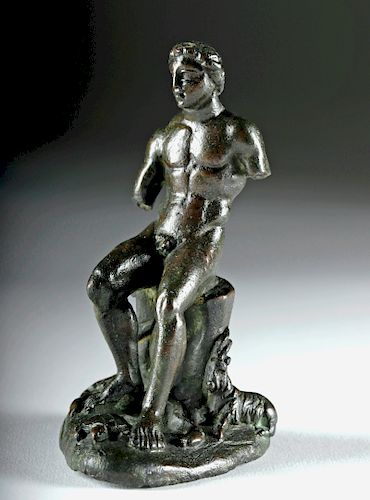Roman Bronze Seated Mercury w/ Animals
Lot 70
About Seller
Artemis Gallery
686 S Taylor Ave, Ste 106
Louisville, CO 80027
United States
Selling antiquities, ancient and ethnographic art online since 1993, Artemis Gallery specializes in Classical Antiquities (Egyptian, Greek, Roman, Near Eastern), Asian, Pre-Columbian, African / Tribal / Oceanographic art. Our extensive inventory includes pottery, stone, metal, wood, glass and textil...Read more
Estimate:
$10,000 - $15,000
Absentee vs Live bid
Two ways to bid:
- Leave a max absentee bid and the platform will bid on your behalf up to your maximum bid during the live auction.
- Bid live during the auction and your bids will be submitted real-time to the auctioneer.
Bid Increments
| Price | Bid Increment |
|---|---|
| $0 | $25 |
| $300 | $50 |
| $1,000 | $100 |
| $2,000 | $250 |
| $5,000 | $500 |
| $10,000 | $1,000 |
| $20,000 | $2,500 |
| $50,000 | $5,000 |
| $100,000 | $10,000 |
| $200,000 | $20,000 |
About Auction
By Artemis Gallery
Feb 21, 2019
Set Reminder
2019-02-21 10:00:00
2019-02-21 10:00:00
America/New_York
Bidsquare
Bidsquare : Exceptional Antiquities, Asian, Ethnographic
https://www.bidsquare.com/auctions/artemis-gallery/exceptional-antiquities-asian-ethnographic-3858
An important one-day auction featuring museum-worthy examples of Egyptian, Greek, Roman, Etruscan, Near Eastern, Far East / Asian, Pre-Columbian, African / Tribal, Oceanic, Native American, Spanish Colonial, Russian, Fossils, Ancient Jewelry, Fine Art, so much more! Artemis Gallery info@artemisgallery.com
An important one-day auction featuring museum-worthy examples of Egyptian, Greek, Roman, Etruscan, Near Eastern, Far East / Asian, Pre-Columbian, African / Tribal, Oceanic, Native American, Spanish Colonial, Russian, Fossils, Ancient Jewelry, Fine Art, so much more! Artemis Gallery info@artemisgallery.com
- Lot Description
Roman, Imperial Period, ca. 1st to 3rd century CE. A wonderful solid bronze seated Mercury (Greek Hermes) surrounded by animals associated with the god - a ram or goat symbolizing fertility sitting beside the rock Mercury sits upon, a tortoise referring to Mercury's invention of the lyre made from a tortoise shell, and serpentine creatures crawling up the boulder, referencing the caduceus or staff with two entwined snakes that Apollo gave to Mercury. Mercury, the god of commerce, poetry, and travelers, guided Roman souls to the underworld. This beautiful statue would have been a votive figure, perhaps kept and prayed to in a wealthy home, deposited in a temple as an offering, or kept as a ritualistic object by a priest. Size: 3.875" H (9.8 cm)
Scholar Martin Robertson deemed the famous bronze "Seated Hermes (Mercury)" from Herculaneum to be a Roman 1st century sculpture rendered after a Greek bronze of the 4th or early 3rd century BCE. Margarete Bieber attributed it to the "School of Lysippos". Interestingly, Brunilde Sismondo Ridgway points out that many bronze sculptures were posed on natural rocks in late Hellenistic and Roman gardens, thus increasing the "idyllic aspect of the composition."
Provenance: private Florida collection; ex-Harmer Rooke Gallery, New York, New York, USA, acquired in May 1995, Lot 157
All items legal to buy/sell under U.S. Statute covering cultural patrimony Code 2600, CHAPTER 14, and are guaranteed to be as described or your money back.
A Certificate of Authenticity will accompany all winning bids.
We ship worldwide and handle all shipping in-house for your convenience.
#142127Losses to lower arms as shown. Minor casting flaws to the periphery of the base. Bronze has developed a rich, deep green and russet patina.Condition
- Shipping Info
-
All shipping is handled in-house for your convenience. Your invoice from Artemis Gallery will include shipping calculation instructions. If in doubt, please inquire BEFORE bidding for estimated shipping costs for individual items.
-
- Buyer's Premium



 EUR
EUR CAD
CAD AUD
AUD GBP
GBP MXN
MXN HKD
HKD CNY
CNY MYR
MYR SEK
SEK SGD
SGD CHF
CHF THB
THB
















